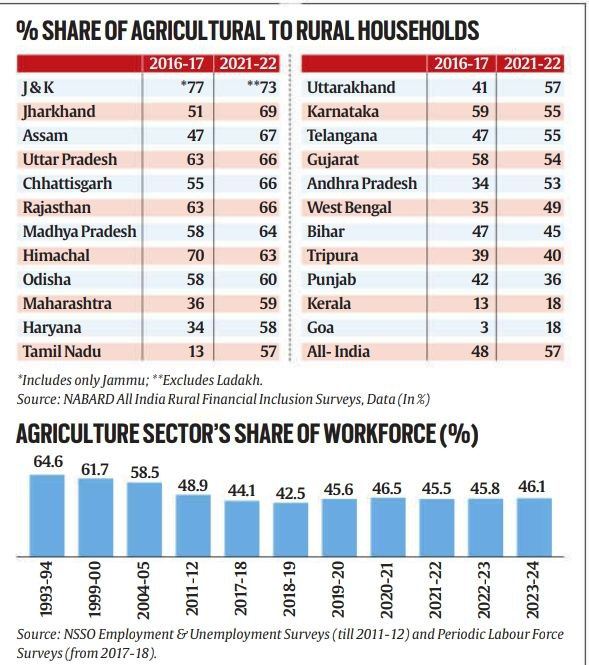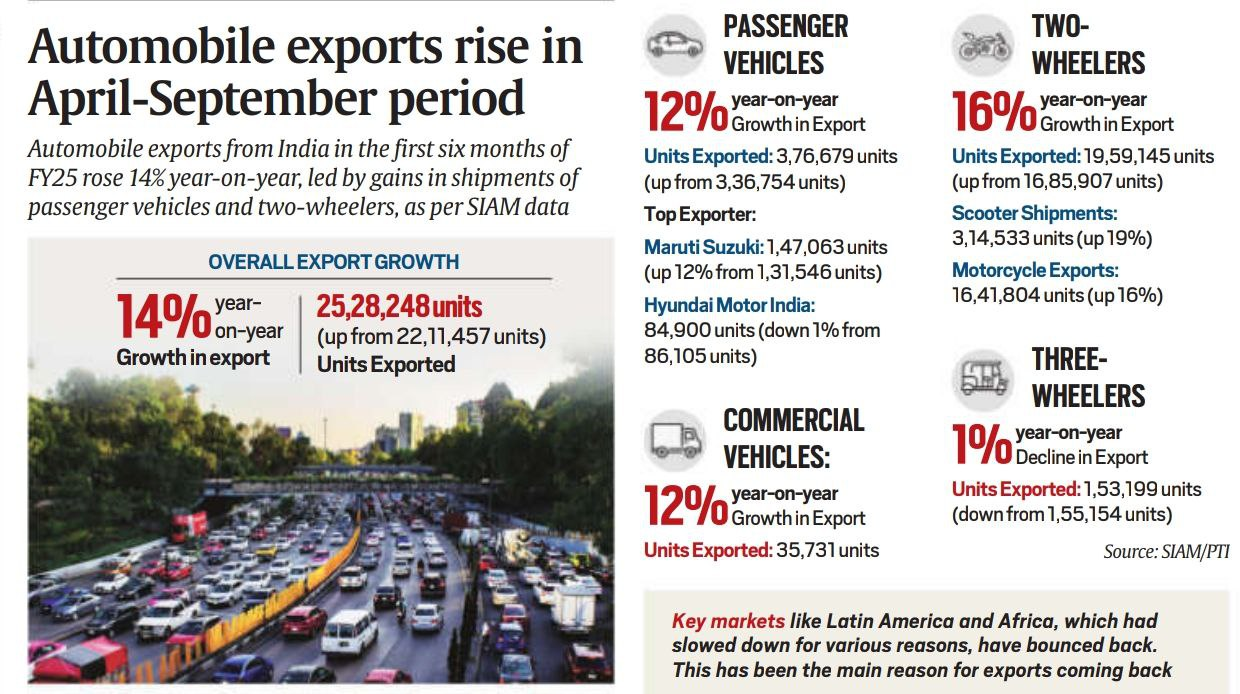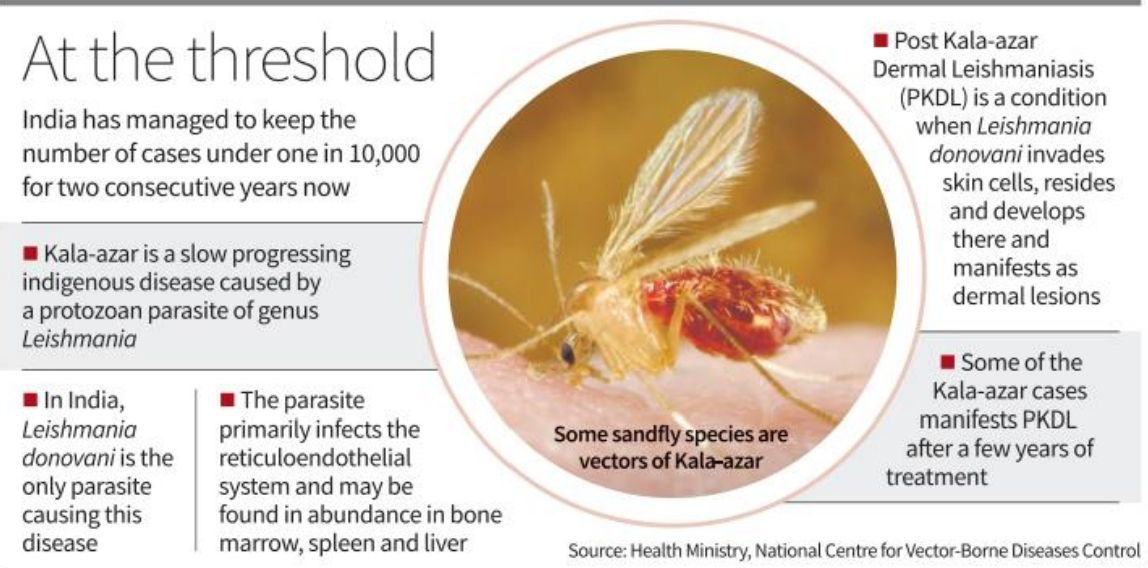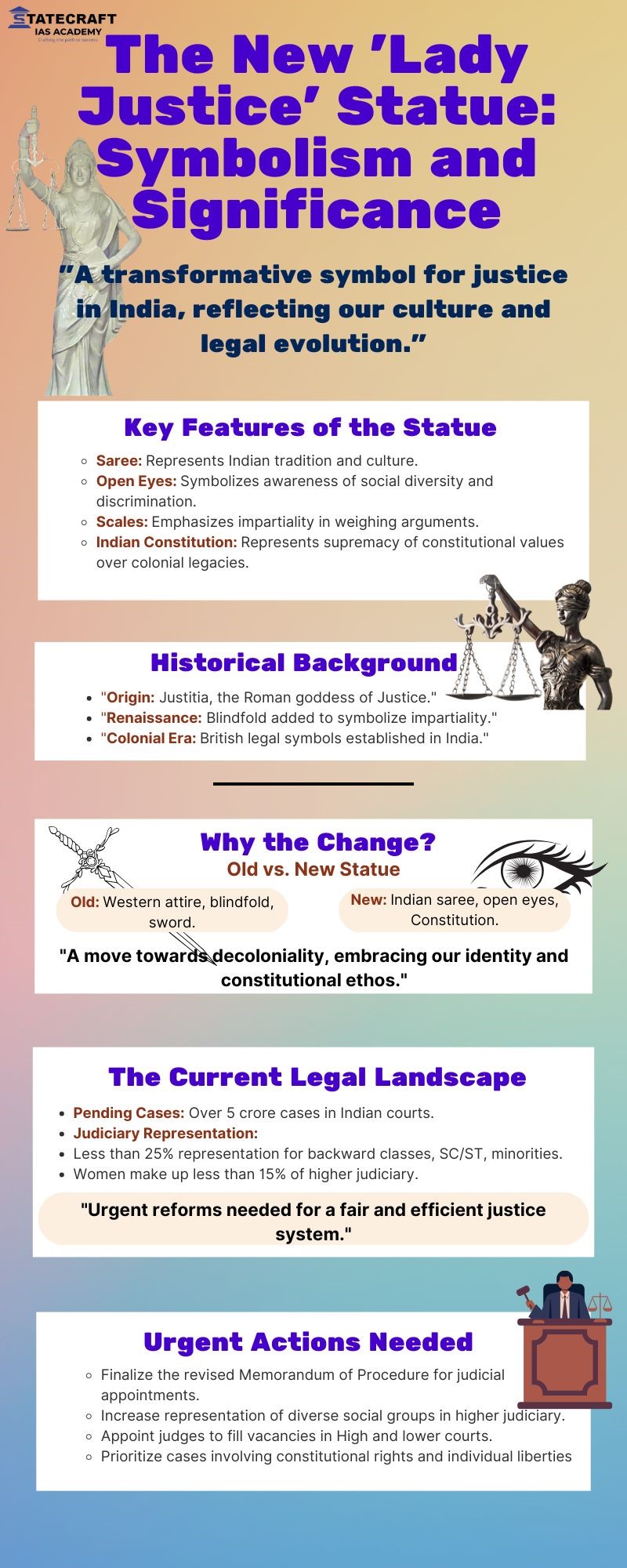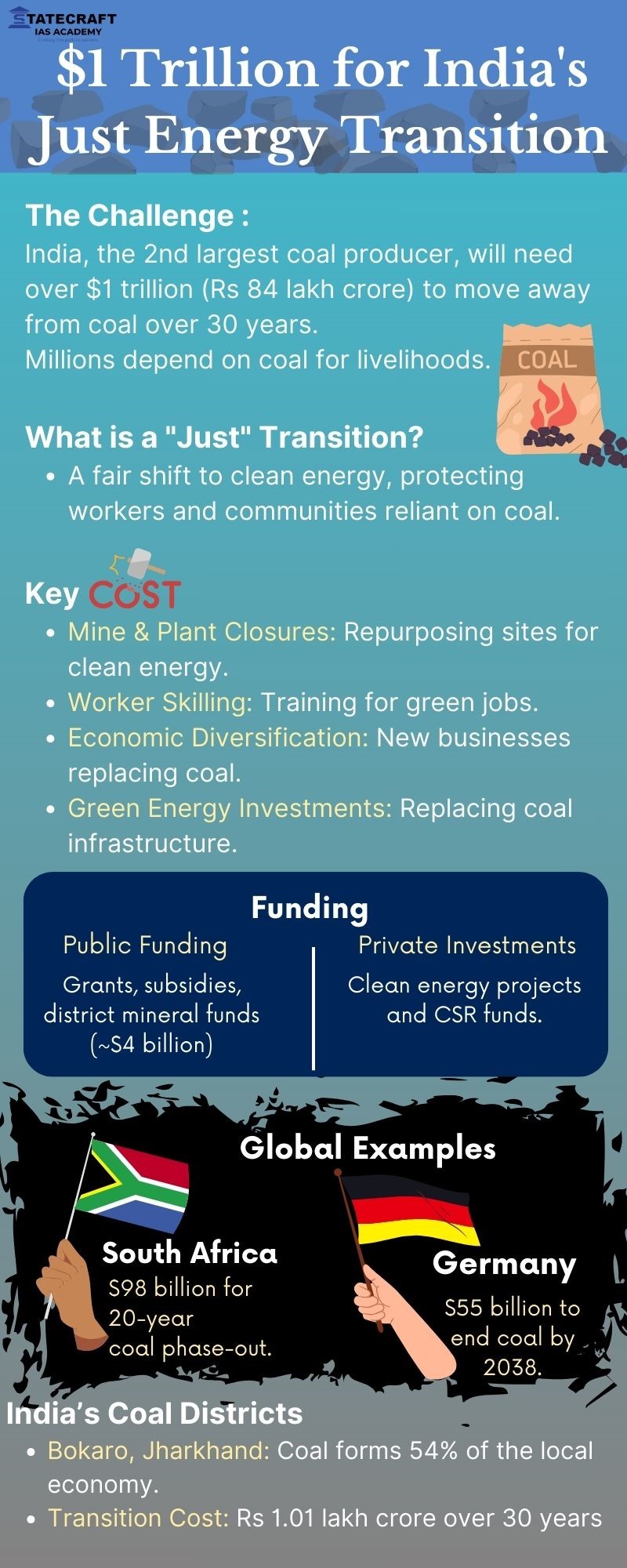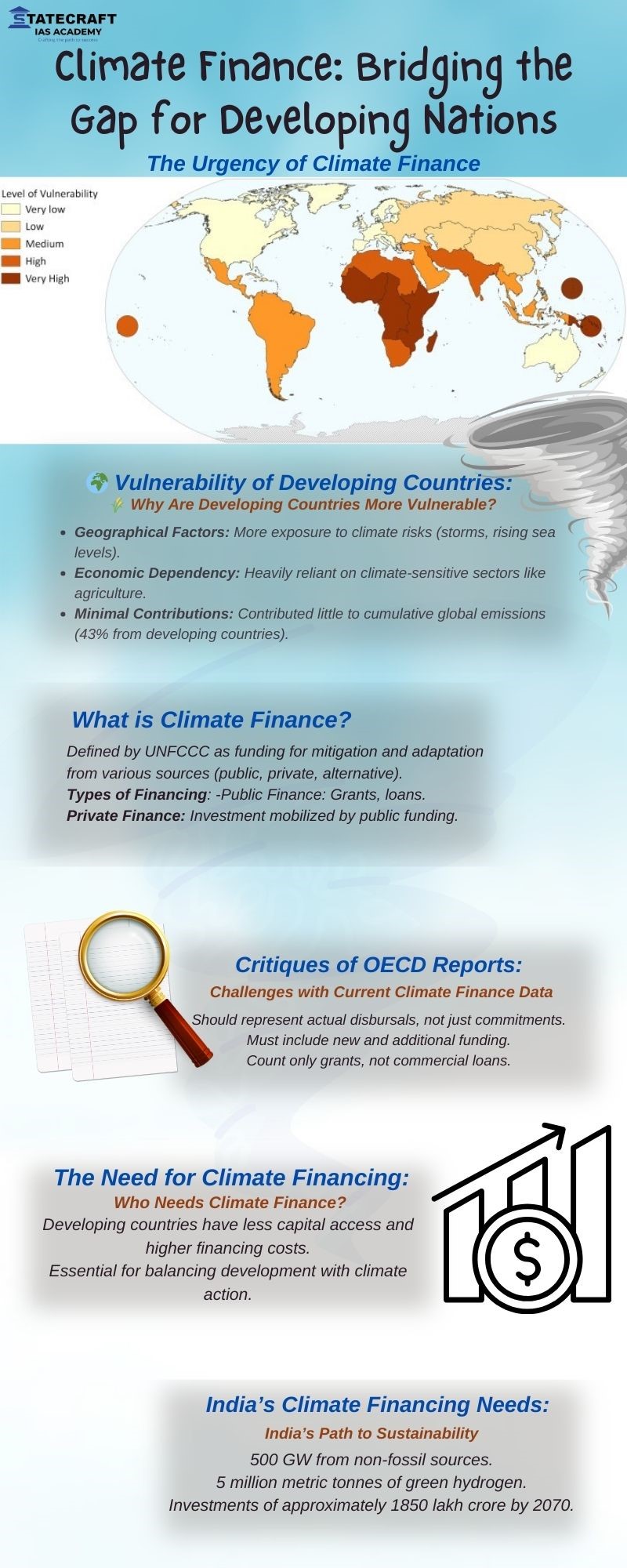Index:
- Comeback of Krishi in Bharat
- Jammu & Kashmir - Resolution for Restoring Statehood
- RBI Action Against NBFCs and Excessive Interest
- India's Performance in Science Nobel Prizes
- Other Headlines
- The New ‘ Lady Justice’ Statute
- $1 Trillion for India's Just Energy Transition
- Climate Finance: Bridging the Gap for Developing Nations
1. Comeback of Krishi in Bharat
- Introduction: The farm sector’s share in employment is increasing despite high GDP growth rates in India, reversing a long-standing trend of rural households moving away from agriculture.
- Survey Data – NABARD’s All India Rural Financial Inclusion Survey (2021-22):
- Agricultural households: Defined as those reporting cultivation or allied agricultural activities and earning over ₹6,500/year from farm produce.
- Key statistic:5% of rural households in 2021-22 were identified as agricultural households, compared to 48% in the 2016-17 survey.
- Increase in dependence on farming noted across many states including Jammu & Kashmir, Jharkhand, Assam, and Chhattisgarh.
- Employment in Agriculture Sector:
- Agriculture’s share of workforce had been declining since 2004 but saw a reverse in trend during the pandemic (2018-23):
- 2018-19:8%
- 2019-20:6%
- 2021-22:1%
- 2022-23:4%
- Increase due to factors like COVID-19-induced economic shifts, migration from cities back to rural areas, and lack of non-farm employment.
- Paradox of Growth:
- Despite the rural sector relying more on agriculture for livelihoods, the economy grew at an average of 3% between 2021-23.
- Agriculture’s GDP share is below pre-pandemic levels, indicating that much of this return to agriculture is due to employment needs rather than productivity increases.
- Impact of COVID-19 Pandemic:
- Job losses in urban sectors, particularly in manufacturing and services, pushed the rural population back towards agriculture.
- Agriculture acted as a safety net during the economic crisis caused by the pandemic.
- Agriculture’s Long-term Trend:
- Over the past two decades, the sector’s share of employment has been in steady decline, from 64.6% in 1993-94 to 45.5% in 2021-22.
- The pandemic reversed this trend, bringing agriculture back as a dominant employer in rural areas.
- Future Implications:
- As urban job markets recover and industrial sectors expand post-pandemic, there could be a renewed migration away from agriculture in the long term.
Policy focus is required on enhancing productivity and improving farm incomes to sustain agricultural growth while diversifying rural employment options.
2. Jammu & Kashmir - Resolution for Restoring Statehood
- Introduction:
- The Lieutenant Governor (L-G) of Jammu & Kashmir, Manoj Sinha, approved a resolution passed by the Omar Abdullah Cabinet to restore statehood to the Union Territory.
- This move marks a significant step in the political reconfiguration of J&K after the revocation of its special status in 2019.
- Cabinet’s Unanimous Resolution:
- The resolution was passed under the chairmanship of Omar Abdullah to reclaim the constitutional rights of the people of Jammu & Kashmir.
- Emphasis on restoring statehood in its original form as a means of protecting the unique identity and constitutional rights of J&K citizens.
- Next Steps:
- The Chief Minister is authorized to meet with the Prime Minister and Union Ministers in New Delhi to push forward the demand for restoring statehood.
- The Cabinet also decided to summon the Legislative Assembly at Srinagar on November 4, where the L-G will address members.
- Significance of Statehood Restoration:
- The resolution views the restoration of statehood as a healing process, which will be crucial for addressing the grievances of the people.
- It also seeks to reaffirm the constitutional protections specific to the region and revive democratic governance.
- Role of the Legislative Assembly:
- The draft address for the L-G’s speech in the Legislative Assembly will outline the future governance structure.
- The Assembly session is expected to commence in the first week of November.
- Pro-tem Speaker Appointment:
- Mubarak Gul, a six-time MLA from the National Conference (NC), was sworn in as the Pro-tem Speaker of the J&K Assembly.
- Gul will oversee the swearing-in of newly elected members of the Assembly on November 4.
- Historical Context:
- Jammu and Kashmir was stripped of its statehood and special status in August 2019, with its bifurcation into two Union Territories: J&K and Ladakh.
The demand for the restoration of statehood has been a long-standing issue, seen as essential for restoring normalcy and democratic rights in the region.
3. RBI Action Against NBFCs and Excessive Interest
- Context: RBI’s Action: The Reserve Bank of India (RBI) has taken strict action against four NBFCs (Non-Banking Financial Companies) for violating various regulations, including unfair loan pricing practices.
- Companies Involved:
- Asirvad Micro Finance Ltd (promoted by Manappuram Finance)
- Arohan Financial Services Ltd
- Navi Finserv (founded by Sachin Bansal)
- Mitsubishi-backed DMI Finance
- Key Issues with NBFCs:
- Usurious Pricing:
- Charging excessive interest rates on loans, especially from small borrowers.
- Violations in handling household income assessments and repayment obligations.
- Non-adherence to interest rate disclosure norms.
- High-Handed Recovery Methods:
- Aggressive recovery practices, including harassment of borrowers.
- Some borrowers experienced sexual harassment and extortion by recovery agents.
- RBI’s Concerns & Charges:
- Exorbitant Interest Rates: The RBI found that the weighted average lending rates (WALR) and interest spreads were excessive and non-transparent.
- Non-Disclosure:
- Failure to disclose interest rates and charges upfront to borrowers.
- Charging interest rates of up to 60% or more.
- Mis-selling of Loans: Breach of data privacy, false representation of products, and hidden charges.
- Key Regulations Violated:
- Income Recognition and Asset Classification (IRAC) Norms:
- Deviations related to improper recognition of loan defaults.
- Non-compliance with gold loan portfolio management.
- Failure in Transparency:
- Not communicating interest rates transparently.
- Digital lending platforms and apps promised ease but misled borrowers.
- Impact on Borrowers:
- High Interest Burden: Borrowers ended up paying 60% more than initially expected due to hidden charges and inflated interest rates.
- Harassment and Abuse: Several cases of harassment, including:
- Extortion by recovery agents.
- Sexual harassment and public shaming for non-repayment.
- Circulation of personal information to family and friends.
- Steps Taken by RBI:
- Guidelines on Digital Lending (September 2022):
- Aimed to protect customers from unethical practices like mis-selling, data breaches, and exorbitant charges.
- Mandated full disclosure of costs and terms before loans are disbursed.
- Examples of Harassment:
- Cases Highlighted:
- A 24-year-old woman harassed by digital lenders who extorted money from her family.
- A 38-year-old salesman, Sandeep Koragvanker, committed suicide after being harassed and publicly shamed by loan recovery agents.
- Predatory Loan Practices:
- Digital Loan Apps: Exploit borrowers by imposing high interest rates and hidden charges.
- Lack of Transparency: Borrowers often unaware of the actual cost of the loans.
- Technological Abuse: Agents misuse borrower information, including sharing private data and sending harassing messages.
4. India's Performance in Science Nobel Prizes
- Since the inception of the Nobel Prize in 1901, only V. Raman (1930) has been awarded the Nobel Prize for Physics while working in India.
- Three other Indian-origin Nobel laureates (Hargobind Khorana, Subrahmanyan Chandrasekhar, and Venkatraman Ramakrishnan) received their awards for work done outside India.
- Reasons for Underperformance:
- Lack of Focus on Basic Science: India’s inadequate attention to basic research and lack of public funding have hindered groundbreaking discoveries.
- Bureaucratic Hurdles: An obstructive and uncreative bureaucracy stifles the environment needed for innovation in science.
- Inadequate Private Sector Involvement: Limited incentives for private research and insufficient infrastructure for scientific advancements.
- Brain Drain: Talented Indian scientists often move abroad for better resources and research opportunities, resulting in a loss of intellectual capital.
- Global Comparison:
- Dominance of US and Europe: The majority of Nobel laureates in science are from the US and Europe due to superior research infrastructure, funding, and focus on scientific development.
- Contributions of Jewish Scientists: Despite being a small percentage of the global population, Jewish scientists have disproportionately won a large number of Nobel Prizes.
- China’s Growing Influence: China has outpaced India with a much larger share of global research and investment in scientific development.
- Notable Omissions: E.C.G. Sudarshan: Fundamental contributions to the work that led to the Physics Nobel in 1979 and 2005. His omission is considered one of the biggest controversies.
- Indian Contributions to Science (Historical Examples):
- Jagadish Chandra Bose: Demonstrated radio waves and other contributions in plant biology, but his work went unrecognized by the Nobel Committee.
S.N. Bose and Bose-Einstein Statistics: Though essential to modern quantum mechanics, Bose was never awarded the Nobel Prize.

